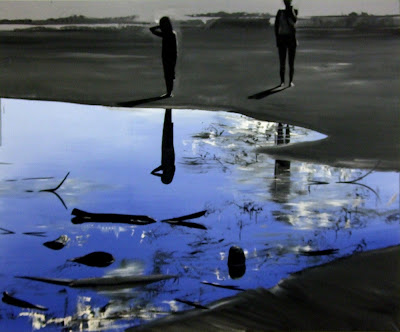Madonna del Parto c1460
Fresco (detached) 206 x 203 cm
Museo della Madonna del Parto, Monterchi
9 September 2008
Having seen the painting located in a chapel[1] in Andrei Tarkovsky’s 1982 film Nostalghia, it came as shock to see the painting coldly displayed as a museum artifact. However, this surprise removed the painting from the context of the film, and perhaps allowed me to see it “for myself” rather than through another’s eyes.

Piero della Francesca gives his Madonna a queenly status, but does so without the usual royal attributes of crown or throne. Instead he uses her relative size and prominence to convey her elevated status, standing between two diminutive angels in a circular pavillion made from animal pelts. This is covered with red velvet damask that is decorated with designs of pomegranates, a symbol of Christ's passion. She turns towards a light source from the left and touches her prominent belly that is exaggerated by the opening in her antenatal gown. Her eyes are asymmetrical, and her gaze is downwards and distinctly melancholic, perhaps reflecting her sorrow at her son’s future death.
The gaze of the angels is straight at the viewer as they reveal the Madonna by holding back the sides of the tent for us to look in. The two angels are mirror images, realised by the artist with the same holed fresco cartoons, and are depicted in alternating colours of red and green. The Madonna’s gown is lapis lazuli blue.
It is a shame that I never saw the painting in the chapel because despite the invitation of the angels to look, the glass case serves as an additional barrier between the world of the painting and that of the viewer, underscoring the metaphysical gulf between the two. In effect, we are only looking at an "essence" of the painting, objectified in a museum, and it is a testament to the power of the original fresco, that its aura can transcend the clinical setting and convey real emotion.
[1] I have subsequently learnt that Tarkovsky used a reproduction of the painting and relocated the action to a church in Tuscany, some 70 miles away in order to recreate the size and atmosphere of the original Capella di Cimitero.







